Hajj2018Wishes,Messages,Status,Quotes,Images,and,More
Hajj2018Wishes,Messages,Status,Quotes,Images,and,More
Hajj2018Wishes,Messages,Status,Quotes,Images,and,More
Etymology
Hajj2018Wishes,Messages,Status,Quotes,Images,and,More
Hajj
| Part of a series on |
| Islam |
|---|
 |
The Hajj ( Arabic: حَجّ Ḥaǧǧ "pilgrimage") is an annual Islamic pilgrimage to Mecca, the holiest city for Muslims, and a mandatory religious duty for Muslims that must be carried out at least once in their lifetime by all adult Muslims who are physically and financially capable of undertaking the journey, and can support their family during their absence. It is one of the five pillars of Islam, alongside Shahadah, Salat, Zakat and Sawm. The Hajj is the second largest annual gathering of Muslims in the world. The state of being physically and financially capable of performing the Hajj is called istita'ah, and a Muslim who fulfills this condition is called a mustati. The Hajj is a demonstration of the solidarity of the Muslim people, and their submission to God (Allah). The word Hajj means "to intend a journey", which connotes both the outward act of a journey and the inward act of intentions.
The pilgrimage occurs from the 8th to 12th (or in some cases 13th) of Dhu al-Hijjah, the last month of the Islamic calendar. Because the Islamic calendar is lunar and the Islamic year is about eleven days shorter than the Gregorian year, the Gregorian date of Hajj changes from year to year. Ihram is the name given to the special spiritual state in which pilgrims wear two white sheets of seamless cloth and abstain from certain actions.
The Hajj is associated with the life of Islamic prophet Muhammad from the 7th century, but the ritual of pilgrimage to Mecca is considered by Muslims to stretch back thousands of years to the time of Abraham. During Hajj, pilgrims join processions of hundreds of thousands of people, who simultaneously converge on Mecca for the week of the Hajj, and perform a series of rituals: each person walks counter-clockwise seven times around the Kaaba (the cube-shaped building and the direction of prayer for the Muslims), runs back and forth between the hills of Safa and Marwah, drinks from the Zamzam Well, goes to the plains of Mount Arafat to stand in vigil, spends a night in the plain of Muzdalifa, and performs symbolic stoning of the devil by throwing stones at three pillars. The pilgrims then shave their heads, perform a ritual of animal sacrifice, and celebrate the three-day global festival of Eid al-Adha.
Pilgrims can also go to Mecca to perform the rituals at other times of the year. This is sometimes called the "lesser pilgrimage", or ‘Umrah (Arabic: عُـمـرَة).[17] However, even if they choose to perform the Umrah, they are still obligated to perform the Hajj at some other point in their lifetime if they have the means to do so, because Umrah is not a substitute for Hajj.
Etymology
The word in Arabic: حج comes from the Hebrew: ח which means "holiday", from the trilateral Semitic root The meaning of the verb is "to circle, to go around". Judaism uses circumambulation in the Hakafot ritual during Hoshanah Rabbah at the end of the Festival of Sukkot and on Simchat Torah; traditionally, Jewish brides circumambulate their grooms during the wedding ceremony under the chuppah. From this custom, the root was borrowed for the familiar meaning of holiday, celebration and festivity. In the Temple, every festival would bring a sacrificial feast. Similarly in Islam, the person who commits the Hajj to Mecca has to turn around the Kaaba and to offer sacrifices
History
The present pattern of Hajj was established by Muhammad.[22] However, according to the Quran, elements of Hajj trace back to the time of Abraham. According to Islamic tradition, Abraham was ordered by God to leave his wife Hajara and his son Ishmael alone in the desert of ancient Mecca. In search of water, Hajara desperately ran seven times between the two hills of Safa and Marwah but found none. Returning in despair to Ishmael, she saw the baby scratching the ground with his leg and a water fountain sprang forth underneath his foot. Later, Abraham was commanded to build the Kaaba (which he did with the help of Ishmael) and to invite people to perform pilgrimage there. The Quran refers to these incidents in verses 2:124-127and 22:27-30 It is said that the archangel Gabriel brought the Black Stone from Heaven to be attached to the Kaaba.
In pre-Islamic Arabia, a time known as jahiliyyah, the Kaaba became surrounded by pagan idols. In 630 CE, Muhammad led his followers from Medina to Mecca, cleansed the Kaaba by destroying all the pagan idols, and then reconsecrated the building to Allah. In 632 CE, Muhammad performed his only and last pilgrimage with a large number of followers, and instructed them on the rites of Hajj. It was from this point that Hajj became one of the five pillars of Islam.
During the medieval times, pilgrims would gather in big cities of Syria, Egypt, and Iraq to go to Mecca in groups and caravans comprising tens of thousands of pilgrims, often under state patronage.[29] Hajj caravans, particularly with the advent of the Mamluk Sultanate and its successor, the Ottoman Empire, were escorted by a military force accompanied by physicians under the command of an amir al-hajj. This was done in order to protect the caravan from Bedouin robbers or natural hazards, and to ensure that the pilgrims were supplied with the necessary provisions. Muslim travelers like Ibn Jubayr and Ibn Battuta have recorded detailed accounts of Hajj-travels of medieval time. The caravans followed well-established routes called in Arabic darb al-hajj, lit. "pilgrimage road", which usually followed ancient routes such as the King's Highway.
Timing of Hajj
The date of Hajj is determined by the Islamic calendar (known as Hijri calendar or AH), which is based on the lunar year.[33][34] Every year, the events of Hajj take place in a five-day period, starting on 8 and ending on 12 Dhu al-Hijjah, the twelfth and last month of the Islamic calendar. Among these five days, the 9th Dhul-Hijjah is known as Day of Arafah, and this day is called the day of Hajj. Because the Islamic calendar is lunar and the Islamic year is about eleven days shorter than the Gregorian year, the Gregorian date for Hajj changes from year to year. Thus, each year in the Gregorian calendar, the pilgrimage starts eleven days (sometimes ten days) earlier than the preceding year.[34][35] This makes it possible for the Hajj season to fall twice in one Gregorian year, and it does so every 33 years. The last time this phenomenon occurred was 2006.[36] The table below shows the Gregorian dates of Hajj of recent years (the dates correspond to 9 Dhul-Hijjah of Hijri calendar):
| 2011 | 2012 | 2013 | 2014 | 2015 | 2016 | 2017 |
|---|---|---|---|---|---|---|
| 5 November | 25 October | 14 October | 3 October | 23 September | 11 September | 31 August |
The date for the next Hajj is the 20th of August, 2018 (Day of Arafat).
Rites
Fiqh literature describes in detail the manners of carrying out the rites of Hajj, and pilgrims generally follow handbooks and expert guides to successfully fulfill the requirements of Hajj. In performing the rites of hajj, the pilgrims not only follow the model of Muhammad, but also commemorate the events associated with Abraham.
Ihram
When the pilgrims reach the appropriate Miqat (depending on where they're coming from), they enter into a state of holiness – known as Ihram – that consists of wearing two white seamless cloths for the male, with the one wrapped around the waist reaching below the knee and the other draped over the left shoulder and tied at the right side; wearing ordinary dress for the female that fulfills the Islamic condition of public dress with hands and face uncovered;taking ablution; declaring the intention (niyah) to perform pilgrimage and to refraining from certain activities such as clipping the nails, shaving any part of the body, having sexual relations; using perfumes, damaging plants, killing animals, covering head (for men) or the face and hands (for women); getting married; or carrying weapons.The ihram is meant to show equality of all pilgrims in front of God: there is no difference between the rich and the poor.
First day of Hajj: 8th Dhu al-Hijjah
On the 8th Dhu al-Hijjah, the pilgrims are reminded of their duties. They again don the ihram garments and confirm their intention to make the pilgrimage. The prohibitions of ihram start now.
Tawaf and sa'ay
The ritual of Tawaf involves walking seven times counterclockwise around the Kaaba.[49] Upon arriving at Al-Masjid Al-Ḥarām(Arabic: الـمَـسـجِـد الـحَـرَام, The Sacred Mosque), pilgrims perform an arrival tawaf either as part of Umrah or as a welcome tawaf.[50] During tawaf, pilgrims also include Hateem – an area at the north side of the Kaaba – inside their path. Each circuit starts with the kissing or touching of the Black Stone (Hajar al- Aswad).[51] If kissing the stone is not possible because of the crowds, they may simply point towards the stone with their hand on each circuit. Eating is not permitted but the drinking of water is allowed, because of the risk of dehydration. Men are encouraged to perform the first three circuits at a hurried pace, known as Ramal, and the following four at a more leisurely pace.[48][page needed][51]
The completion of Tawaf is followed by two Rakaat prayers at the Place of Abraham (Muqam Ibrahim), a site near the Kaaba inside the mosque.[51][52] However, again because of large crowds during the days of Hajj, they may instead pray anywhere in the mosque. After prayer, pilgrims also drink water from the Zamzam well, which is made available in coolers throughout the Mosque.[53]
Although the circuits around the Kaaba are traditionally done on the ground level, Tawaf is now also performed on the first floor and roof of the mosque because of the large crowds.
Tawaf is followed by sa'ay, running or walking seven times between the hills of Safa and Marwah, located near the Kaaba.[49][52] Previously in open air, the place is now entirely enclosed by the Sacred Mosque, and can be accessed via air-conditioned tunnels.[54] Pilgrims are advised to walk the circuit, though two green pillars mark a short section of the path where they run. There is also an internal "express lane" for the disabled. After sayee, the male pilgrims shave their heads and women generally clip a portion of their hair, which completes the Umrah.
Mina[edit]
After the morning prayer on the 8th of Dhu al-Hijjah, the pilgrims proceed to Mina where they spend the whole day and offer noon, afternoon, evening, and night prayers.[55] The next morning after morning prayer, they leave Mina to go to Arafat.Second day: 9th Dhu al-Hijjah[edit]
The 9th Dhul-Hijjah is known as Day of Arafah, and this day is called the Day of Hajj.Arafat[edit]
On 9th Dhu al-Hijjah before noon, pilgrims arrive at Arafat, a barren and plain land some 20 kilometers east of Mecca, where they stand in contemplative vigil: they offer supplications, repent on and atone for their past sins, and seek mercy of God, and listen to sermon from the Islamic scholars who deliver it from near Jabal al-Rahmah (The Mount of Mercy) from where Muhammad is said to have delivered his last sermon. Lasting from noon through sunset, this is known as 'standing before God' (wuquf), one of the most significant rites of Hajj. At Masjid al-Namirah, pilgrims offer noon and afternoon prayers together at noon time. A pilgrim's Hajj is considered invalid if they do not spend the afternoon on Arafat.Muzdalifah
Pilgrims must leave Arafat for Muzdalifah after sunset without praying maghrib (sunset) prayer at Arafat. Muzdalifah is an area between Arafat and Mina. Upon reaching there, pilgrims perform Maghrib and Isha prayer jointly, spend the night praying and sleeping on the ground with open sky, and gather pebbles for the next day's ritual of the stoning of the Devil (Shaitan).Third day: 10th Dhu al-Hijjah
After returning from Muzdalifah, the Pilgrims spend the night at Mina.Ramy al-Jamarat
Back at Mina, the pilgrims perform symbolic stoning of the devil (Ramy al-Jamarat) by throwing seven stones at only the largest of the three pillars, known as Jamrat al-Aqabah from sunrise to sunset. The remaining two pillars (jamarah) are not stoned on this day. These pillars are said to represent Satan.[ Pilgrims climb ramps to the multi-levelled Jamaraat Bridge, from which they can throw their pebbles at the jamarat. Because of safety reasons, in 2004 the pillars were replaced by long walls, with catch basins below to collect the pebbles.Animal sacrifice
After the casting of stones, animals are slaughtered to commemorate the story of Abraham and Ishmael. Traditionally the pilgrims slaughtered the animal themselves, or oversaw the slaughtering. Today many pilgrims buy a sacrifice voucher in Mecca before the greater Hajj begins, which allows an animal to be slaughtered in the name of God (Allah) on the 10th, without the pilgrim being physically present. Modern abattoirs complete the processing of the meat, which is then sent as charity to poor people around the world. At the same time as the sacrifices occur at Mecca, Muslims worldwide perform similar sacrifices, in a three-day global festival called Eid al-Adha.Hair removal
After sacrificing an animal, another important rite of Hajj is shaving head or trimming hair (known as Halak). All male pilgrims shave their head or trim their hair on the day of Eid al Adha and women pilgrims cut the tips of their hair.Tawaf Ziyarat
On the same or the following day, the pilgrims re-visit the Sacred Mosque in Mecca for another tawaf, known as Tawaf al-Ifadah, an essential part of Hajj.It symbolizes being in a hurry to respond to God and show love for Him, an obligatory part of the Hajj. The night of the 10th is spent back at Mina.Fourth day: 11th Dhu al-Hijjah
Starting from noon to sunset on the 11 Dhu al-Hijjah (and again the following day), the pilgrims again throw seven pebbles at each of the three pillars in Mina. This is commonly known as the "Stoning of the Devil".Fifth day: 12th Dhu al-Hijjah
On 12 Dhu al-Hijjah, the same process of stoning of the pillars as of 11 Dhu al-Hijjah takes place.Pilgrims may leave Mina for Mecca before sunset on the 12th.Last day at Mina: 13th Dhu al-Hijjah
If unable to leave on the 12th before sunset or opt to stay at free will, they must perform the stoning ritual again on the 13th before returning to Mecca.Tawaf al-Wadaa
Finally, before leaving Mecca, pilgrims perform a farewell tawaf called the Tawaf al-Wadaa. 'Wadaa' means 'to bid farewell'. The pilgrims circle the Kaaba seven times counter-clockwise, and if they can, attempt to touch or kiss the Kaaba.Journey to Medina
Though not a part of Hajj, pilgrims may choose to travel to the city of Medina and the Al-Masjid an-Nabawi (Mosque of the Prophet), which contains Muhammad's tomb. The Quba Mosque and Masjid al-Qiblatayn are also usually visited.Arrangement and facilities
Making necessary arrangements each year for the growing number of pilgrims poses a logistic challenge for the government of Saudi Arabia, which has, since the 1950s, spent more than $100 billion to increase pilgrimage facilities. Major issues like housing, transportation, sanitation, and health care have been addressed and improved greatly by the government by introducing various development programs, with the result that pilgrims now enjoy modern facilities and perform various rites at ease.The Saudi government often sets quota for various countries to keep the pilgrims' number at a manageable level, and arranges huge security forces and CCTV cameras to maintain overall safety during Hajj. Various institutions and government programs, such as the Haj subsidy offered in India or the Tabung Haji based in Malaysia assist pilgrims in covering the costs of the journey. For 2014 Hajj, special Hajj information desks were set up at Pakistani airports to assist the pilgrims.Visa requirements
In order to enter Saudi Arabia to participate in the Hajj, visa requirements exist.Transportation
Traditionally, the pilgrimage to Mecca was mainly an overland journey using camels as a means of transport. During the second half of the nineteenth century (after 1850s), steamships began to be used in the pilgrimage journey to Mecca, and the number of pilgrims traveling on sea route increased. This continued for some time, until air travel came to predominate; Egyptintroduced the first airline service for Hajj pilgrims in 1937. Today, many airlines and travel agents offer Hajj packages, and arrange for transportation and accommodation for the pilgrims. King Abdulaziz International Airport in Jeddah and Prince Mohammad Bin Abdulaziz Airport in Medina have dedicated pilgrim terminals to assist the arrival of pilgrims.Other international airports around the world, such as Indira Gandhi in New Delhi, Rajiv Gandhi International Airport in Hyderabad, Jinnah in Karachi and Soekarno-Hatta in Jakarta also have dedicated terminals or temporary facilities to service pilgrims as they depart and return home. During Hajj, many airlines run extra flights to accommodate the large number of pilgrims.During official Hajj days, pilgrims travel between the different locations by bus or on foot. The Saudi government strictly controls vehicles access into these heavily congested areas. However, the journey could take many hours due to heavy vehicular and pedestrian traffic. In 2010, the Saudi government started operating a metro rail service that runs between Arafat, Muzdalifa and Mina. The service shortens the travel time during the critical "Nafrah" from Arafat to Muzdalifah to minutes. Due to its limited capacity, the use of the metro is not open to all pilgrims and is subject to strict controls by Saudi officials.Modern crowd-control problems
Pilgrim numbers have greatly increased in recent years, which has led to numerous accidents and deaths due to overcrowding. The first major accident during Hajj in modern times occurred in 1990, when a tunnel stampede led to the death of 1,462 people.Afterwards, various crowd-control techniques were adopted to ensure safety. Because of large crowds, some of the rituals have become more symbolic. For example, it is no longer necessary to kiss the Black Stone. Instead, pilgrims simply point at it on each circuit around the Kaaba. Also, the large pillars used for pebble throwing were changed into long walls in 2004 with basins below to catch the stones. Another example is that animal sacrifice is now done at slaughterhouses appointed by the Saudi authorities, without the pilgrims being present there.For Hajj in 2016, Saudi authorities will also be giving pilgrims GPS-tracked electronic bracelets.Despite safety measures, incidents may happen during the Hajj as pilgrims are trampled or ramps collapse under the weight of the many visitors. During 2015 Hajj, a stampede resulted in 769 deaths and injuries to 934 others, according to the Saudi authorities. A report from Associated Press totalled at least 1470 fatalities from official reports from other countries, making it the most deadly such episode to date.Concerns were raised in 2013 and 2014 about the spread of MERSbecause of mass gatherings during the Hajj. Saudi Health Minister Abdullah Al-Rabia said authorities have detected no cases of MERS among the pilgrims so far. He also said that, despite few cases of MERS, Saudi Arabia was ready for the 2014 pilgrimage.In November 2017, Saudi authorities banned selfies at the two holy sites
Significance[edit]
To the Muslims, Hajj is associated with religious as well as social significance.[96] Nevertheless, it should be noted that the obligation for performing this pilgrimage is only fulfilled if it is done on the eighth to twelfth day of the last month of the Islamic calendar. If in a given year, an adult Muslim is in good health and his life and wealth is safe, they must perform the Hajj in the same year. Delaying it is considered sinful unless the delay is caused by reasons beyond his/her control.[97]Apart from being an obligatory religious duty, the Hajj is seen to have a spiritual merit that provides the Muslims with an opportunity of self-renewal.[96] Hajj serves as a reminder of the Day of Judgment when Muslims believe people will stand before God.[98] Hadith literature (sayings of Muhammad) articulates various merits a pilgrim achieves upon successful completion of their Hajj.[n 3] After successful pilgrimage, pilgrims can prefix their names with the title 'Al-Hajji', and are held with respect in Muslim society.[99] However, Islamic scholars suggest Hajj should signify a Muslim's religious commitment, and should not be a measurement of their social status.[99]Hajj brings together and unites the Muslims from different parts of the world irrespective of their race, colour, and culture, which acts as a symbol of equality.[7][64]A 2008 study on the impact of participating in the Islamic pilgrimage found that Muslim communities become more positive and tolerant after Hajj experience. Titled Estimating the Impact of the Hajj: Religion and Tolerance in Islam's Global Gathering and conducted in conjunction with Harvard University's John F. Kennedy School of Government, the study noted that the Hajj "increases belief in equality and harmony among ethnic groups and Islamic sects and leads to more favorable attitudes toward women, including greater acceptance of female education and employment" and that "Hajjis show increased belief in peace, and in equality and harmony among adherents of different religions."[100]Malcolm X, an American activist during the Civil Rights Movement, describes the sociological atmosphere he experienced at his Hajj in the 1960s as follows:Number of pilgrims per year
There has been a substantial increase in the number of pilgrims during the last 92 years, and the number of foreign pilgrims has increased by approximately 2,824 percent, from 58,584 in 1920 to 1,712,962 in 2012.[104] Because of development and expansion work at Masjid al-Haram, the authority restricted the number of pilgrims in 2013.[105][106] The following number of pilgrims arrived in Saudi Arabia each year to perform Hajj.Year Hijri year Local pilgrims Foreign pilgrims Total 1920 1338 58,584[104] 1921 1339 57,255[104] 1922 1340 56,319[104] 1950 1369 100,000 (approx.)[3] 1950s 150,000 (approx.) 1960s 300,000 (approx.) 1970s 700,000 (approx.) 1980s 900,000 (approx.) 1989 1409 774,600 1990 1410 827,200 1991 1411 720,100 1992 1412 1,015,700 1993 1413 992,800 1994 1414 997,40 1995 1415 1,046,307 1996 1416 784,769 1,080,465 1,865,234 1997 1417 774,260 1,168,591 1,942,851 1998 1418 699,770 1,132,344 1,832,114 1999 1419 775,268 1,056,730 1,831,998 2000 1420 466,430 1,267,355 1,733,785 2001 1421 440,808 1,363,992 1,804,800 2002 1422 590,576 1,354,184 1,944,760 2003 1423 493,230 1,431,012 1,924,242 2004 1424 473,004 1,419,706 1,892,710 2005 1425 1,030,000 (approx.) 1,534,769 2,560,000 (approx.) 2006 1426 573,147 1,557,447 2,130,594 2006 1427 724,229 1,654,407 2,378,636 2007 1428 746,511 1,707,814 2,454,325[ 2008 1429 1,729,841 2009 1430 154,000 1,613,000 2,521,000 2010 1431 989,798 1,799,601 2,854,345 2011 1432 1,099,522 1,828,195 2,927,717 2012 1433 1,408,641 1,752,932 3,161,573 2013 1434 700,000 (approx.) 1,379,531 2,061,573 (approx.) 2014 1435 700,000 (approx.) 1,389,053 2,089,053 (approx.) 2015 1436 615,059 (approx.) 1,384,941 2,000,000 (approx.) 2016 1437 537,537 1,325,372 1,862,909 2017 1438 2,000,000 (approx.) Differences between the Hajj and Umrah
- Both are Islamic pilgrimages, the main difference is their level of importance and the method of observance.
- Hajj is one of the five pillars of Islam. It is obligatory for every Muslim once in their lifetime, provided they are physically fit and financially capable.
- Hajj is performed over specific days during a designated Islamic month. However, Umrah can be performed at any time.
- Although they share common rites, Umrah can be performed in less than a few hours while Hajj is more time consuming, and involves more rituals.
Gallery
- Thanks For Visitng Our Website

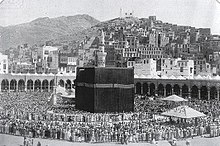






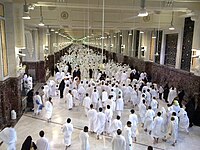
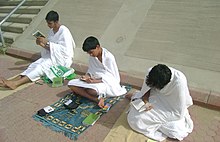




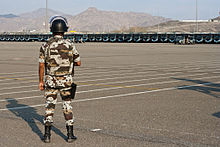





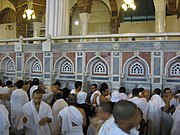









No comments